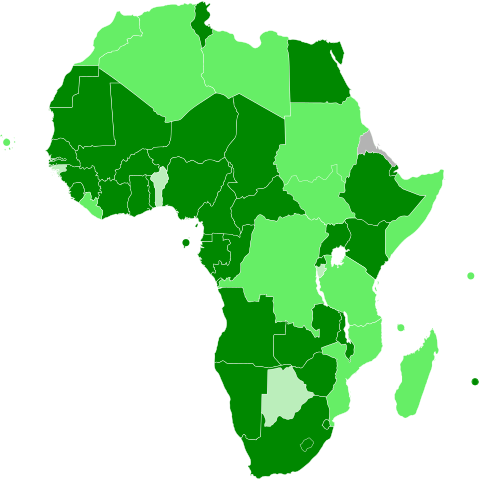On November 2, 2018, the Africa World Institute organized in partnership with Sophia University in Tokyo (Japan) and the Catholic University of Central Africa (Yaoundé, Cameroon) a symposium on African Tales as a tool for conflict resolution, at the Centre Sèvres (35 bis Rue de Sèvres, 75006 Paris).
On this occasion, Ms. Atsuko Nagai, professor at Sophia University in Tokyo, spoke on intercultural access to African stories.
Find here his intervention.
Disturbed “Waiting Horizon”: Intercultural access to African stories
I. Popular tales in globalization
Folk tales contain myths and morals that serve to strengthen the social order and solidarity of a community in which they are originally rooted.
That is why we now feel that popular tales radically change their status. In the globalization of the economic market and human resources, young people leaving their villages to train and work in a large city do not hesitate to go even abroad to find a better condition for success. The depopulation of local communities thus changes the way stories are transmitted. The disconnected connection with the natural environment and the native community in which the stories were rooted, their social and traditional role, are changing. But this will not prevent the spirit of the tales from maintaining its standard of action.
Globalisation can also bring virtues to traditional tales that we would not have imagined in the past. Today, they allow us to make intercultural discoveries. A Japanese businessman who had difficulty understanding the reactions of Ivorians when he opened a business in Côte d’Ivoire bought textbooks and anthologies of Ivorian stories to serve as an introduction to Ivorian society. On the other hand, stories from other cultures teach us that norms of action and thought are not necessarily shared by all peoples of the world. In this way, they allow us to get to know each other better, to put our habits into perspective and thus avoid conflicts in our intercultural relations.
I will analyse a new intercultural effectiveness of sub-Saharan African stories based on Alfred Jauss’ theory of the “waiting horizon”. This classical theory, both historical and phenomenological, seems to me to be useful in analysing the reception of popular tales.
II. The solidity of the waiting horizon for popular tales.
Let us begin by recalling the theory of the “horizon of expectation” that Jauss describes in Histoire de la littérature as provocation (1974): “the horizon of expectation of his first public[= of the work], i.e. the objectively formable reference system that (…) results from three main factors: the public’s prior experience of the genre to which it belongs, the form and theme of earlier works of which it presupposes knowledge, and the opposition between poetic language and practical language, imaginary world and everyday reality[1].”
Storytelling is a literary genre through particular common elements that cross cultures. The common points concern both form and content. Tales often begin with an expression such as: “once upon a time”, which separates the reality of the timeless world from the tales. Then, while the story takes place in a familiar place and climate, there are wonderful and unreal phenomena such as talking animals, trees carrying coins, etc… These common points even allow the reader of tales from other cultures to put himself, according to Jauss’ expression, “in such and such an emotional disposition” which, from the beginning, creates “a certain expectation of the “following”, the “middle” and the “end” of the story[2]”. The “waiting horizon” of the stories is so solid that it is barely blurred when it comes to themes common to all, such as the protective love of parents for their children. Such a discovery of commonalities that allows us to be empathetic with people from other cultures shows the emotional and social utility of stories in the age of globalization. But when this “waiting horizon” is disturbed, it can also be a good opportunity to rediscover ourselves and better understand others.
III. The “waiting horizon” is disturbed
About the “waiting horizon” disturbed by the reading of foreign tales, let me present some personal experiences. At the end of a tale from sub-Saharan Africa, I sometimes think: “Is that all? Does the story end well? ». For example, let us recall a well-known episode of the turtle that deceives the leopard. It has several variations in Camourenese tales[3]. In this tale, the hungry turtle and leopard decide to kill their mother to eat them together. The turtle pretends to kill her by spilling mahogany powder into the river. And she puts resin in her package instead of her mother still alive, while thinking that the turtle had kept its promise, the leopard killed her mother. Then the turtle eats with him the leopard mother’s flesh. Finally, the turtle managed to escape from the leopard’s claws.
What surprised me in this tale is that the turtle succeeds in deceiving the leopard and takes advantage of his trust and stupidity and, despite that, does not pay for his cheating at the end of the tale! Those who know the fauna of the region would tell me that when the turtle, which is smaller, slower than the leopard, cheats on it with timeliness, it encourages us by showing that a state of inferiority such as physical weakness can be overcome if we have courage and tact. Indeed, Paul N’Da, political sociologist of tales and traditions in Africa, notes that tales lend particular power to the sick, the weak and the marginalized, particularly to oppose them to evil beings and thwart their intrigues[4].
Let us take another example from the tales of the Fulbe people recorded in northern Togo by Kazuhisa Eguchi, a Japanese ethnologist to whom we will pay tribute at the end of the symposium. In these tales, the agile and clever hare often presents a complete contrast with the inattentive and stupid hyena. In this tale, the hare that goes up a tree meets a young girl. She serves him a good meal with a plucked rooster and millet balls. She then gives him good advice on how to make a profit and he succeeds. The next day, the hyena who had heard of the hare’s luck climbed the same tree. The same meal was served to her, but she did not follow the young girl’s good advice, and finally she died under the bee stings[5].
The success of the hare fulfils our wish for success. But he’s lying to the girl’s mother. When she comes home, the mother asks her if the rooster has already been served and he answers in the negative. He managed to have a good meal twice in a row. What caught my attention most of all was that he betrayed those who showed him great hospitality and kindness without compensation. The “waiting horizon” of the Japanese storyteller is disturbed by the insolence of the hare who lies to his benefactors and who is not punished for it! My “waiting horizon” would not be disturbed if the successful hare, who climbed the tree after the hyena, died stung by bees for lying to the girl’s mother.
But I am not the only Japanese woman who is sensitive to smart animals like turtles and hares that succeed in African stories. Professor Yumiko Sakuma, who is one of the most famous translators of children’s books from Africa to Japan, draws our attention to the fact that in many traditional African tales the trickster appears and that small animals continue to deceive adults without being caught at the end. Japanese folk tales are, according to Sakuma, more ethically ordered: benefactors are rewarded and criminals punished. On the other hand, the traditional African tales in which the trickster manages to escape seem to him to keep a primitive form and it is for this reason that she is interested in them[6]. I do not immediately classify the hare in the trickster category because it does not confuse the presupposed social order. But the reader is sensitive to aspects that blur the “horizon of waiting” preformed by the tales of his native country. It is therefore possible that remarks made by foreigners may differ from those of readers in the countries of origin of the stories. In fact, in studies of African tales by Africans, clever animals that have succeeded by trickery and gone unpunished do not seem to be at the heart of their analysis.
IV. The traditional tales that form the “waiting horizon” of the Japanese
What surprises Japanese people reading traditional tales from Africa depends on the qualitative gap between the stories and the “waiting horizon” already drawn in the mind by traditional tales from Japan. We will therefore present some episodes with which the Japanese must compare, even unconsciously, passages of the turtle or hare that have succeeded in African tales. I will draw some examples from the nationally known and widespread tales, which were traditionally transmitted to farmers.
In Japan, there is a well-used expression: “Kanzen chôaku” which means “to advise good and punish evil”. One should not generalize too much and synthesize morality, but the spirit of this expression is one of the most essential pillars of traditional tales. In Japanese stories, there is very often a person who treats some animal or other creature with kindness and is later rewarded by being saved. The fisherman Urashima, hero of one of the most famous tales, rescues a sea turtle mistreated by children on a beach, and later, to thank the fisherman, the turtle takes him to a paradise under the sea. In another well-known tale, a crane was delivered by a man who bought it from the one who had trapped it. One day, the crane transformed into a beautiful woman comes to see the man who lived alone with his mother and asks her to marry him. Since then, she has locked herself in a room to weave quality canvases to enrich the home. But breaking the prohibition, when the man opens the door of the room, he finds the crane taking his feathers to weave them. In another story, on December 31, a poor man went to sell hemp ropes in vain and exchanged them for vegetable strand hats that an elderly person has difficulty selling. On the way back, he wears this hat with a Buddhist statue of stone frozen under the snow. In the night, this statue comes to thank him at home and leaves him a big bag full of gold and silver coins. In such numerous episodes, informed of a neighbour who has been rewarded for his charity, the one who has imitated him while waiting for a reward fails while trying to make more profit from it. In the well-known tale, entitled “The Sparrow with his tongue cut out”, an old man kindly raises a sparrow, while his wife, furious that he has tasted rice and lied by accusing the cat, cuts out his tongue and abandons him. Her husband takes pity on him and goes to get him. He finally finds his home. The sparrow serves him a good meal and makes him choose between a small package and a large one as a gift. The old man chooses the smallest one in which there are many gold coins. His wife is also going to see the sparrow. He makes her choose between the small or the big package. Greedy, she chose the biggest one from which came out snakes, vipers and centipedes that killed her. In another well-known tale entitled “The Old Flower Bearer”, it is the contrast between an elderly, modest and kind couple, and the greedy and jealous neighbouring couple. A small dog found and fed by the first couple offers them a lot of money. But the dog gives all kinds of unpleasant animals to their neighbours who have imitated the couple in the hope of becoming so rich. Furious, they kill the small dog, but beyond death the dog continues to offer a lot of money to the couple who loved and cared for him while it makes the jealous and greedy couple unhappy[7].
In these stories, those who do good without ulterior motives become rich while those who hide their wickedness and imitate benefactors in the hope of making a profit are punished. These stories are based on the banal maxim: “to advise good and punish evil”. No people can advise against following this adage. But why is the “waiting horizon” of Japanese readers disturbed when reading African tales?
V. Envy, waiting for punishment
The “waiting horizon” of readers too accustomed to the oppositional scheme between beneficence / reward and malfeasance / punishment is disturbed in front of the warmly welcomed uncharitable hare and the criminal hare that is not punished. That’s why these readers can’t stand the luck of the cunning hare. Let’s clarify what they think about the hare. Even if they do not intend to accuse him, they do not want to congratulate him either. It is true that the rabbit’s trick does not bring any misfortune to his neighbours, but they cannot remain indifferent to his luck. They are jealous and envious of the success of the hare. They feel less rewarded and less happy than this clever hare and wait to see if the hare is well punished and becomes unhappy. The loss of the hare is an indirect revenge and reward for readers who think they are living honestly. Otherwise, their “waiting horizon” remains troubled until the end. This is how the Japanese reader sometimes gets the impression: “Is that all? “at the end of the African tale.
In this regard, in his book The Call to Study (1872-1876), Yukichi Fukuzawa (1834-1901), one of the most famous thinkers and educators of the nineteenth century restoration era, was wary of the Japanese envy, which seemed remarkable to him compared to that of the English or Americans. He considers envy as “the vice of vices”, because envy makes, according to him, “people dissatisfied with their condition compared to that of others, it pushes them to attack the latter without ever personally questioning themselves or seeking to act by themselves to remove the causes of the frustration experienced”. Fukuzawa states that “envious people are people who think only of themselves, never taking into account the common interest[8]”. It is true that tales such as “The Sparrow with his tongue cut out” and “The Old Flower Bearer” advise the Japanese not to be envious. But is it not also true that a rigorous application of the principle of “advising good and punishing evil” would encourage the envy of those who succeed by avoiding the precept: “evil returns to the one who does it”?
On the other hand, if the success of the smart hare and the cunning turtle does not bother African readers much, it is probably because they are not so dominated by envy and are relatively indifferent to the happiness of others. These qualities, which can be tools to avoid conflicts, are so obvious that they are too obvious to them. But they manifest themselves in the light of the reaction of readers from other cultures. Similarly, the African tales invite us to recognize that a narrow-minded respect for honesty can turn into jealousy and a lack of generosity that can lead to conflict. They also invite us to historically examine our standards of action through storytelling. Because the oppositional pattern between beneficence / reward and evil / punishment found in the most famous traditional Japanese tales has been especially accentuated by the national education of children after the modernization of the country and it is possible that we can find in other more local, less known tales, more generous mentalities, more disinterested to the happiness of others, closer to the free nature of the tales of Africa. In any case, the reception of intercultural stories can nowadays bring new and as yet undeveloped ways of using the confrontations of globalization.
Atsuko NAGAI (Sophia University)
SUMMARY
Globalisation can bring virtues to traditional tales that we would not have imagined in the past. The reader of folk tales from other cultures is sensitive to aspects that blur the “horizon of expectation”, to use Hans Robert Jauss’ expression, preformed by the tales of his native country. If the success of the malignant hare and the cunning turtle in the tales of sub-Saharan Africa blurs the “waiting horizon” of the Japanese reader, it is because he is too accustomed to the oppositional scheme between benefit / reward and evil / recurrent punishment in his country’s tales and likely to encourage the envy of those who succeed. The qualities, which can be tools to avoid conflict, are evident to African readers in the light of the reaction of readers from other cultures.
[1]Hans Robert Jauss, Pour une esthétique de la réception, Gallimard, Paris, 1978, p. 49.
[2]Hans Robert Jauss, Ib., p. 50.
[3] Gabriel E.Mfomo, Soirées au Village : Contes du Cameroun, Karthala, 2011, p. 80-82.
[4]Paul N’Da, Alliances à plaisanterie, proberbes et contes en Afrique de la tradition : Pour une société d’entraide, de solidarité et de justice, L’Harmattan, 2017, p. 80.
[5]«Le lièvre et la hyène qui sont montés dans un baobab merveilleux», Une pauvre hyène : contes folkloriques du Togo en Afrique, Kazuhisa Eguchi, 1984, Komine shoten, p. 26-32.
[6]Yumiko Sakuma, «Sur les contes d’Afrique pleins de forces vitales», Kono hon yondé, hiver 2017, JPIC, p. 53.
[7]édité par Keigo Seki, Nihon no mukashi banashi (I), (II), (III), Iwanami bunko, 1956~1957, Iwanami shoten.
[8]Fukuzawa Yukichi, L’Appel à l’étude, Les Belles Lettres, Paris, 2018, p.134-135.




